车载诊断系统(OBD)精讲
- 格式:ppt
- 大小:1.85 MB
- 文档页数:36
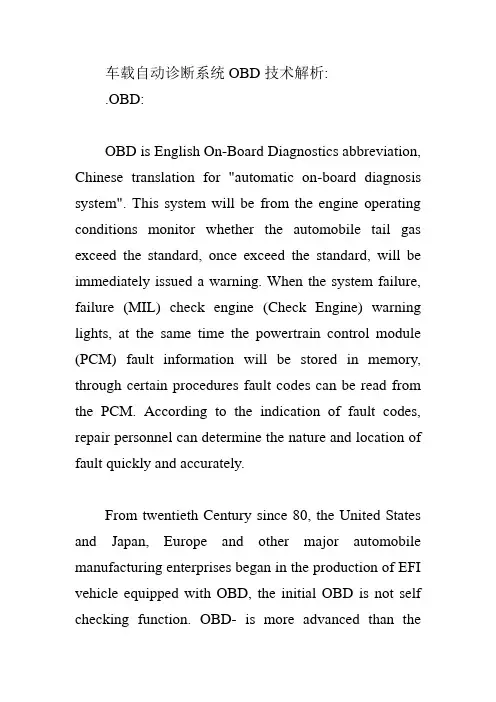
车载自动诊断系统OBD技术解析:.OBD:OBD is English On-Board Diagnostics abbreviation, Chinese translation for "automatic on-board diagnosis system". This system will be from the engine operating conditions monitor whether the automobile tail gas exceed the standard, once exceed the standard, will be immediately issued a warning. When the system failure, failure (MIL) check engine (Check Engine) warning lights, at the same time the powertrain control module (PCM) fault information will be stored in memory, through certain procedures fault codes can be read from the PCM. According to the indication of fault codes, repair personnel can determine the nature and location of fault quickly and accurately.From twentieth Century since 80, the United States and Japan, Europe and other major automobile manufacturing enterprises began in the production of EFI vehicle equipped with OBD, the initial OBD is not self checking function. OBD- is more advanced than theOBD II in twentieth Century 90 time metaphase, American society of Automotive Engineers (SAE) developed a set of standard specification, requirement each automobile manufacturing enterprises to provide diagnosis model according to unified OBD- II standards, in twentieth Century 90 years late, the car entered the North American market in accordance with the new standard setting OBD. OBD- II and all on board before self diagnostic system is different with the strict emissions targeted, the matter of fact is the performance of vehicle emissions monitoring. When the vehicle emissions of carbon monoxide (CO), hydrocarbons (HC), nitrogen oxides (NOx) or fuel evaporation amount of pollution exceeds the set standard, the lamp will light fault alarm. Although the OBD- II is very effective for vehicle emissions monitoring, but the driver acceptance warning all by "consciousness". Therefore, OBD- is more advanced than the OBD- II III produced.OBD- III main purpose is to make the vehicle detection, maintenance and management as a whole, in order to meet the requirements of environmentalprotection. OBD- system can respectively into the engine, gearbox, ABS ECU system (computer) to read the fault code and other related data, and the use of small vehicle communication system, such as GPS navigation system or wireless communication management department will automatically notice vehicle identity code, the fault code and location information, management department according to the the vehicle emission problems of grades on its issued a directive, including where to repair advice, to solve the time, also be to beyond the time limit offenders vehicles issued a ban for instruction. Therefore, the OBD- system can not only on the vehicle emission issues warning to the driver, but also carry out punishment for offenders.Reportedly, some models of the introduction of domestic joint venture automobile factory in recent years also have production and sales in Europe, which itself is equipped with OBD and reached the European III and even the European IV standard, domestic often minus OBD on or off, on the one hand is to save cost, but also caused trouble in order to avoid the oil quality is not upto the situation because the OBD alarm. Beijing in the implementation of Euro III standard, will require cars to increase OBD equipment. Allegedly Euro III standard in Beijing implementation of the first year manufacturers can not install OBD, but from the beginning of the second year will make this requirement.OBD是英文On-Board Diagnostics的缩写,中文翻译为“车载自动诊断系统”。
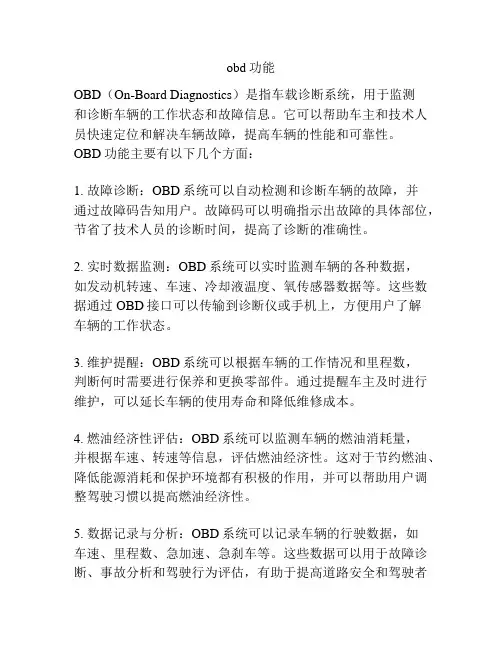
obd功能OBD(On-Board Diagnostics)是指车载诊断系统,用于监测和诊断车辆的工作状态和故障信息。
它可以帮助车主和技术人员快速定位和解决车辆故障,提高车辆的性能和可靠性。
OBD功能主要有以下几个方面:1. 故障诊断:OBD系统可以自动检测和诊断车辆的故障,并通过故障码告知用户。
故障码可以明确指示出故障的具体部位,节省了技术人员的诊断时间,提高了诊断的准确性。
2. 实时数据监测:OBD系统可以实时监测车辆的各种数据,如发动机转速、车速、冷却液温度、氧传感器数据等。
这些数据通过OBD接口可以传输到诊断仪或手机上,方便用户了解车辆的工作状态。
3. 维护提醒:OBD系统可以根据车辆的工作情况和里程数,判断何时需要进行保养和更换零部件。
通过提醒车主及时进行维护,可以延长车辆的使用寿命和降低维修成本。
4. 燃油经济性评估:OBD系统可以监测车辆的燃油消耗量,并根据车速、转速等信息,评估燃油经济性。
这对于节约燃油、降低能源消耗和保护环境都有积极的作用,并可以帮助用户调整驾驶习惯以提高燃油经济性。
5. 数据记录与分析:OBD系统可以记录车辆的行驶数据,如车速、里程数、急加速、急刹车等。
这些数据可以用于故障诊断、事故分析和驾驶行为评估,有助于提高道路安全和驾驶者的行为规范。
6. 车辆安全:OBD系统可以与车辆的安全系统进行集成,如防盗系统、刹车系统等。
当发生异常情况时,OBD系统可以通过警告灯、声音等方式提醒驾驶者及时采取措施,提高车辆的安全性。
总之,OBD功能为车主和技术人员提供了方便快捷的车辆诊断与维护手段,可以及时发现和解决车辆的故障,提高车辆的性能和可靠性。
在今后的发展中,OBD功能将会越来越智能化,为用户提供更多实用的车辆信息和服务。
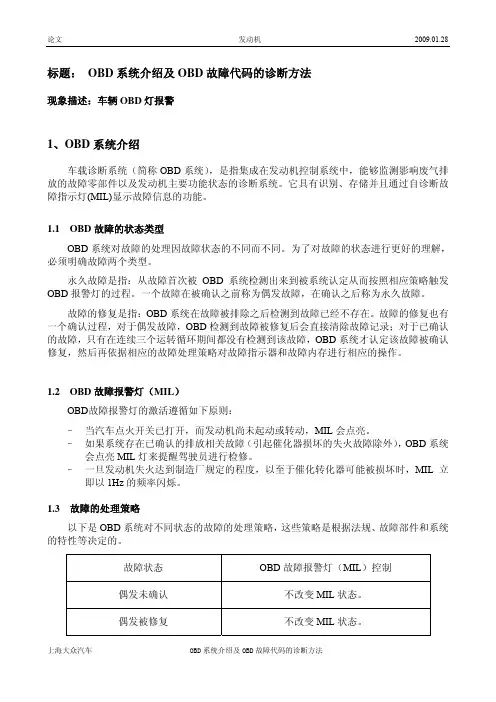

汽车诊断与车载诊断系统(OBD)简介1 概述汽车诊断(Vehicle Diagnosis)是指对汽车在不解体(或仅卸下个别零件)的条件下,确定汽车的技术状况,查明故障部位及原因的检查。
随着现代电子技术、计算机和通信技术的发展,汽车诊断技术已经由早期依赖于有经验的维修人员的“望闻问切”,发展成为依靠各种先进的仪器设备,对汽车进行快速、安全、准确的不解体检测。
为了满足美国环保局(EPA)的排放标准,20世纪70年代和80年代初,汽车制造商开始采用电子控制燃油输送和点火系统,并发现配备空燃比控制系统的车辆如果排放污染超过管制值时,其氧传感器通常也有异常,由此逐渐衍生出设计一套可监控各排放控制元件的系统,以在早期发现可能超出污染标准的问题车辆。
这就是车载诊断系统(On-Board Diagnostics,缩写为OBD)。
OBD系统随时监控发动机工况以及尾气排放情况,当尾气超标或发动机出现异常后,车内仪表盘上的故障灯(MIL)或检查发动机灯(Check Engine)亮,同时动力总成控制模块(PCM)将故障信息存入存储器,通过一定的程序可以将故障码从PCM中读出。
根据故障码,维修人员能迅速准确地确定故障的性质和部位。
OBD-II是20世纪90年代推出的新的ODB标准,几乎提供了完整的发动机控制,并监控底盘、车身和辅助设备,以及汽车的诊断控制网络。
2 汽车诊断接口OBD - II的规范规定了标准的硬件接口-- 16针(2x8)的J1962插座。
OBD - II接口必须在方向盘2英尺范围内,一般在方向盘下。
SAE的 J1962定义了OBD-II接口的引脚分配如下:<?xml:namespace prefix = v /??>图1 J1962标准插座表13 与汽车诊断有关的主要通信协议20世纪90年代中期,为了规范车载网络的研究设计与生产应用,美国汽车工程师协会(SAE)下属的汽车网络委员会按照数据传输速率划分把车载网络分为Class A、Class B、Class C表2 车载网络分类目前OBD使用的通信协议主要有5种:ISO9141、KWP2000、SAEJ1850(PWM)、SAEJ1850(VPW)、CAN。


车载自动诊断系统及使用要点车载自动诊断系统及使用要点随着汽车技术的不断发展,车载自动诊断系统已经成为当今汽车技术的重要组成部分。
车载自动诊断系统简称OBD,它是汽车电子控制系统中的一部分,主要用于实时监测和诊断车辆的工作状况,以及对车辆故障进行识别和提示。
本文将介绍车载自动诊断系统及其使用要点,为车主或汽车维修工提供一些参考意见。
一、车载自动诊断系统的基本概念车载自动诊断系统是指一套由多个传感器、电子控制模块以及软件程序组成的系统,通过对车辆各个内部系统的检测和监控,实现对车辆各项功能进行分析和评估,提供对车辆工作状态的诊断结果。
OBD是车载自动诊断系统的一部分,它是On-Board Diagnostics(车载诊断)的缩写。
由于车载OBD系统能够实时监测和检测汽车电子控制系统的运行状况,同时能够及时提示车主或修理员发现的问题,因此在汽车维修和日常保养中起着至关重要的作用。
二、车载自动诊断系统的组成车载自动诊断系统包括传感器、ECU(电子控制单元)和诊断工具。
传感器主要用于测量车辆各个部位的数据,如温度、速度、气压等。
ECU是车载电子控制模块,主要负责收集传感器的数据,并通过车辆总线与其它模块通讯,实现对车辆的控制和管理。
诊断工具主要用于读取ECU存储的故障码以及进行初步的故障诊断。
三、车载自动诊断系统的使用要点1. 检查传感器和电子控制模块的供电和接线是否正常,尤其是一些易损部位,如线束接头等。
2. 定期检查车辆的OBD系统,尽量避免OBD诊断器出现意外意外损坏或失去读取故障码的功能。
3. 如果发现故障码,请及时进行初步的故障诊断,争取尽快修复故障。
一旦发现故障,不要擅自使用车辆,否则汽车可能会更加严重的损坏。
4. 遵守OBD诊断器使用的正确方法,正确选择适合OBD诊断器的操作系统和操作方法。
要注意正确连接OBD诊断器和车辆,建议先阅读使用说明书。
5. 发现故障后,不要盲目地将ECU或传感器等部件进行更换,这样很可能会对车辆造成不必要的损害和浪费。


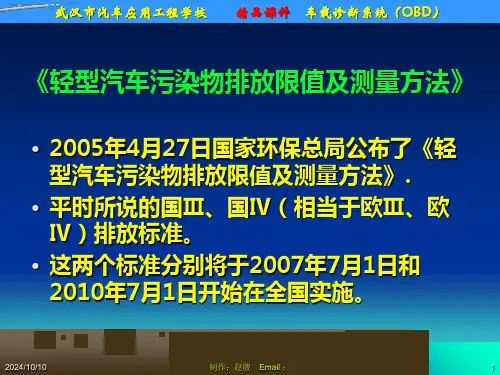

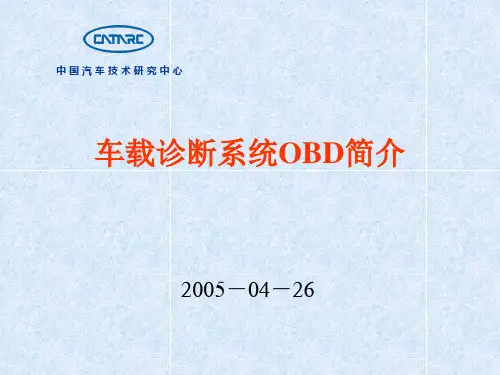
车载诊断系统(OBD)简介及认证随着汽车技术的不断进步和普及,现代汽车除了具备基本的驾驶功能外,还具备了许多高级功能。
其中,车载诊断系统(OBD)是一种常见的汽车电子控制系统。
什么是OBD?OBD(On-board Diagnostics)是指车载诊断系统。
它是由汽车制造商、车辆技术服务提供商和国家机构共同制定的标准,并在汽车上实现的一个系统,用于监控和诊断所有与引擎和传动系统相关的信息。
OBD通过车载电脑接收车辆各种传感器信号,检测车辆系统是否正常工作并进行诊断。
如果出现了问题,OBD会记录故障代码,方便技师进行维修。
OBD在汽车出现故障时,可以帮助驾驶员更快更精确地定位故障位置,减少了修理费用和时间。
并且,由于OBD可以实现车辆监控,可以最大程度地保证汽车的安全性和性能,减少污染和能源损耗。
OBD的认证OBD是为了消费者和技术服务提供商制定的一个统一标准。
每个制造商都必须按照该标准设计、生产、销售和维修车辆。
这意味着,OBD需要得到认证。
认证是指汽车制造商证明其产品符合特定标准的过程。
在OBD方面,主要分为两个类别,即OBD-I和OBD-II。
OBD-IOBD-I是指20世纪80年代和90年代初期的汽车,由于技术的限制,OBD-I无法记录实时数据。
诊断过程需要使用指定的手动方式,需要通过特殊工具才能读取诊断代码。
OBD-IIOBD-II是指20世纪90年代后期以及21世纪的车辆,所有OBD-II汽车都可以读取实时数据。
OBD-II需要使用标准的扫描工具,可以通过汽车诊断仪器进行远程故障诊断和数据记录。
为了使汽车制造商遵守规定并证明其汽车符合规定,所有OBD-II车辆必须接受OBD-II认证。
在美国,环保署(EPA)和交通部(DOT)都负责监督OBD-II认证,这也是一个汽车制造商在美国销售汽车的必要条件。
OBD的标准OBD的标准具有国际性,某些OBD规格和标准适用于世界各个地区。
美国制定了最常见的OBD系统,即OBD-II系统,因此,未来世界其他地区的OBD系统可能会与OBD-II系统有所不同。